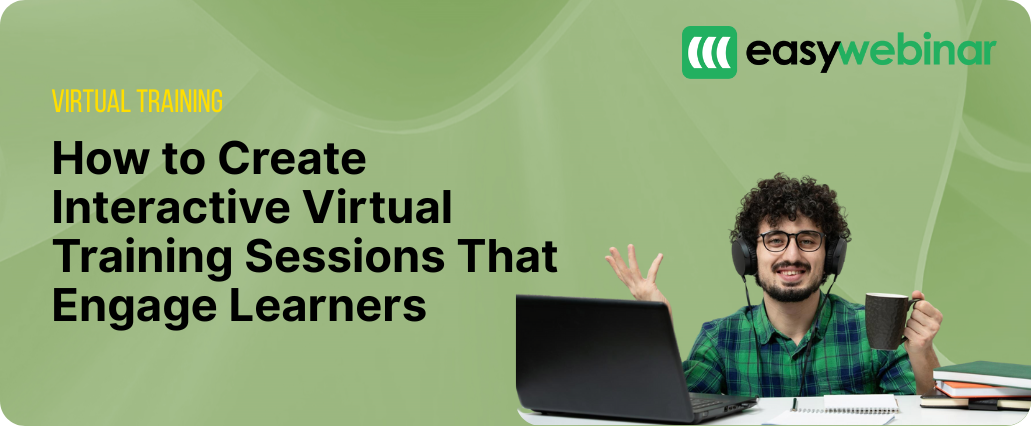Virtual Training: How to Create Interactive Virtual Training Sessions That Engage Learners

Summary :
Interactive virtual training sessions are essential for keeping learners engaged, improving knowledge retention, and boosting overall training effectiveness. By moving away from passive learning methods, trainers can create immersive experiences that encourage active participation, critical thinking, and skill application. This blog explores proven strategies for designing virtual training sessions that captivate participants, including the use of interactive elements like click-and-reveal content, quizzes, drag-and-drop activities, branching scenarios, and real-time engagement features such as live polls and Q&A. It also highlights the importance of inclusive practices, Universal Design for Learning (UDL), and content localization to ensure all learners can benefit, regardless of background or location. Trainers will learn how to balance content delivery with interaction, set clear learning objectives, implement adaptive learning paths, and encourage peer feedback. Using EasyWebinar’s robust engagement tools, organizations can turn mundane virtual sessions into dynamic, collaborative, and impactful learning experiences that drive retention, satisfaction, and real-world performance.
Table of Contents
- Why interactive virtual training matters
- Types of interactive elements to include
- Designing effective virtual training sessions
- Conclusion
- FAQs
A surprising 70% of employees admit they get distracted at work. Virtual training environments make this challenge even more obvious, as participant involvement becomes crucial for success.
Interactive virtual training sessions turn passive participants into active learners. Passive learning resembles riding a bus, while interactive learning puts your participants in the driver’s seat, literally like driving a car. Research shows that interactive content substantially improves learner involvement and performance in online training.
Active learning strategies go beyond just getting participants to do things, they make people think about their actions. Thoughtful planning and implementation of interactive elements make virtual training more compelling. Participation and knowledge retention improve when you use click-and-reveal content and create breakout rooms for shared activities.
This piece provides practical strategies, virtual training activities, and proven tips that create interactive learning experiences to keep your participants focused and motivated. You’ll learn how to turn your sessions from forgettable presentations into dynamic learning experiences, whether you’re starting with virtual training or want to improve your current approach.
Why interactive virtual training matters
The development of corporate training shows a fundamental change in learning philosophy through interactive virtual sessions, going beyond mere technological adaptation.
The change from passive to active learning
Traditional training methods depend on passive approaches where participants absorb information through lectures or videos. Research shows people remember only about 30% of what they read and a mere 20% of what they see. Active learning changes this dynamic by making learners participants rather than spectators.
Learners become directly involved through experiences that demand participation in active learning. Participants blend, analyze, and apply knowledge instead of receiving one-directional information. This method creates a shared environment where learners build knowledge through meaningful interactions with instructors, content, and peers.
The main difference lies in the control of the learning experience. Passive learning puts instructors in charge of content delivery, while active learning strengthens participants to find and apply concepts through discussions, problem-solving tasks, and hands-on activities.
Benefits of engagement: retention, satisfaction, performance
Interactive virtual training benefits reach way beyond novelty. Engagement dramatically improves knowledge retention. Interactive virtual learning increases engagement by 50% and boosts knowledge retention by more than 20%. Additionally, participants retain approximately 90% of the knowledge gained through hands-on experience.
Student satisfaction rises substantially with interactivity. Research shows that satisfaction directly correlates with student engagement and academic performance. Interactive elements like polls, quizzes, and discussions create accountability that reduces multitasking and increases focus.
Organizations find that interactive training improves real-life performance most compellingly. Experiential learning increases learning quality by up to 75%, while employees in virtual training retain up to 60% more information than those in traditional settings. This leads to faster skill acquisition, improved confidence, and better knowledge application on the job.
Interactive synchronous learning experiences support mental well-being beyond professional benefits—a crucial factor in today’s distributed work environment.

Types of interactive elements to include
Virtual training sessions need interactive elements that turn viewers into active participants. Here’s a look at the best interactive components you can add to your next session.
Click-and-reveal and tabbed content
Click-and-reveal interactions make complex content easier to understand. They break large chunks of information into smaller, digestible pieces. Learners can click to reveal hidden content through tabs, timelines, or labeled graphics. This method reduces cognitive load because it shows only relevant information at a time. Students explore content at their own pace. Tabs work great to organize related content that belongs together, which creates a clean and accessible interface.
Drag-and-drop and matching activities
Drag-and-drop activities boost engagement and help students retain information better. Learners can move objects to specific areas – sort items, match terms with definitions, or put process steps in order. Even compliance training becomes interesting when learners drag safety equipment onto characters or place hazardous materials in proper containers. Plus, these activities help both visual and text-based learners understand and remember concepts better.
Quizzes and knowledge checks
Knowledge checks make assessments interesting. These quick pulse-checks help students understand how well they’re learning throughout a session. Good knowledge checks come in several formats:
- Multiple-choice and multiple-response questions
- Fill-in-the-blank and matching exercises
- Hotspot questions for image interpretation
Students get immediate feedback that helps them learn from mistakes right away and reinforces key concepts when they matter most.
Interactive videos and simulations
Interactive videos include questions, hotspots, and decision points throughout the content. Students remember up to 30% more compared to regular videos. Simulations create safe environments where learners practice ground skills. This approach enhances motivation and fosters collaborative skills.
Branching scenarios and role-play
Branching scenarios create custom learning paths based on each student’s decisions. These scenarios work like “Choose Your Own Adventure” stories. Students face realistic situations where their choices lead to different outcomes. This setup helps develop decision-making skills safely. Role-playing activities let participants practice people skills, get direct feedback, and learn through experience.
Designing effective virtual training sessions
Virtual training needs thoughtful design decisions that go beyond picking interactive elements. The most impactful sessions come from careful planning that puts the learner’s experience first.
Set clear learning objectives
Good learning objectives tell participants what they will accomplish after training. These objectives need four key parts: audience, behavior, condition, and degree of mastery. Your organization’s strategy should line up with specific, measurable, and time-bound objectives.
Use adaptive learning paths
Each learner’s knowledge level determines their personalized experience through adaptive learning. Learners can skip familiar topics and focus on challenging areas. This method cuts down scrap learning, which makes up 45% of corporate learning. Learners stay more engaged because the content matches their individual needs.
Incorporate self-assessment tools
Participants get instant feedback from self-assessment tools to check their understanding during sessions. These tools help learners think about their learning process. Students can spot gaps in their knowledge and take charge of their learning experience.
Balance content with interaction
Audience interaction should happen every 10 minutes. The best approach mixes content delivery with activities. You should plan five slides of engaging activities and five slides of content for each thirty-minute block.
Utilize EasyWebinar’s Engagement Features
EasyWebinar provides dependable interactive tools like live polls, Q&A sessions, and real-time chat. These features turn passive viewers into active participants, helping trainers maintain attention and foster engagement throughout the session.
Making Virtual Training Inclusive and Collaborative
Virtual training is most effective when it encourages collaboration and shared learning. By promoting teamwork and active participation, you can create an environment where learners feel seen, heard, and valued.
Encourage Peer Feedback and Discussion
Peer feedback transforms learners from passive listeners into active contributors. It deepens understanding and encourages critical thinking. To make this process effective:
- Use a structured feedback framework or rubric
- Encourage participants to begin with positive observations before suggesting improvements
- When possible, include multiple reviewers for balanced input
- Allow revisions based on feedback received
Ensure Accessibility with Universal Design
Applying Universal Design for Learning (UDL) principles ensures that virtual training sessions are inclusive and accessible for everyone. Key practices include:
- Offering materials in multiple formats (text, audio, video)
- Allowing customization in how information is displayed
- Providing different ways for learners to demonstrate understanding
- Removing barriers that could limit participation
Localize Content for Global Teams
When teams include members from different regions or language backgrounds, localizing training materials becomes essential. Go beyond simple translation, adapt examples, visuals, and tone to suit the cultural context. This makes learning more relatable and inclusive for everyone.

Conclusion
Active, involving learning experiences have replaced traditional passive approaches in virtual training. Participants who take the driver’s seat instead of being passengers show better knowledge retention and application.
Mundane training sessions can become dynamic learning experiences by implementing interactive elements. Click-and-reveal content, drag-and-drop activities, and knowledge checks make a difference. These strategies boost retention by up to 20% and improve learning quality by 75%.
Quality virtual training needs more than interactive components. Learning objectives, balanced content delivery, and adaptive learning paths create meaningful learning trips. EasyWebinar’s strong engagement features offer an ideal platform with live polls, Q&A functionality, and chat options that keep participants involved.
Inclusive and collaborative methods ensure equal benefits for all participants. Everyone can contribute and learn effectively through breakout rooms, peer feedback, and universal design principles, whatever their background or learning style.
Your next virtual training session should involve participants every 10 minutes. This method turns passive viewers into active learners who retain and apply information better in ground scenarios. The right tools and strategies help virtual training deliver exceptional results that benefit participants and organizations.
FAQs
Q1. How can I make virtual training sessions more interactive?
To increase interactivity, incorporate elements like click-and-reveal content, drag-and-drop activities, quizzes, and interactive videos. Use breakout rooms for small group discussions, encourage peer feedback, and leverage engagement features like live polls and Q&A sessions. Remember to include an interactive element at least every 10 minutes to keep participants engaged.
Q2. What are the benefits of interactive virtual training?
Interactive virtual training improves knowledge retention by up to 20% and increases learning quality by as much as 75%. It boosts engagement, enhances satisfaction, and improves real-world performance. Participants retain around 90% of knowledge gained through hands-on experience, leading to faster skill acquisition and better application of knowledge on the job.
Q3. How can I ensure my virtual training is inclusive for all participants?
Implement Universal Design for Learning principles by providing content in multiple formats, offering customization options, and removing participation barriers. Localize content for global teams, considering cultural context beyond mere translation. Use adaptive learning paths to cater to individual needs and incorporate self-assessment tools to support metacognition.
Q4. What’s the ideal balance between content delivery and interaction in virtual training?
Aim for a 50/50 split between content delivery and interactive activities. A good rule of thumb is to alternate between five slides of content and five slides of engaging activities for each 30-minute segment. Never go more than 10 minutes without audience interaction to maintain engagement throughout the session.
Q5. How can I effectively use breakout rooms in virtual training?
Keep breakout groups small, ideally 2-3 participants per room, to ensure active participation. Schedule the first breakout activity within the first 10 minutes of your session. Provide clear instructions, including specific outcomes, collaboration methods, time limits (under 12 minutes), and assigned roles. Use breakout rooms for group work, problem-solving, and peer feedback to enhance collaboration and learning.